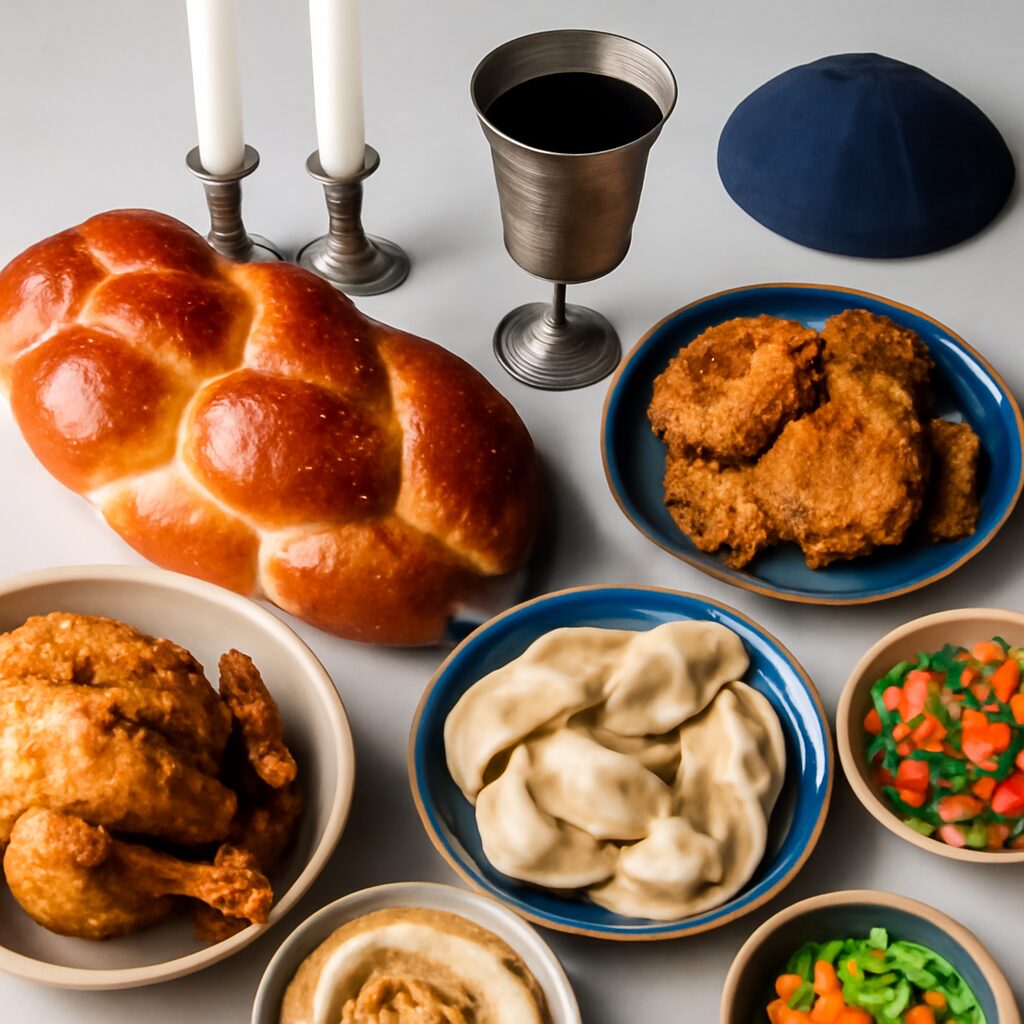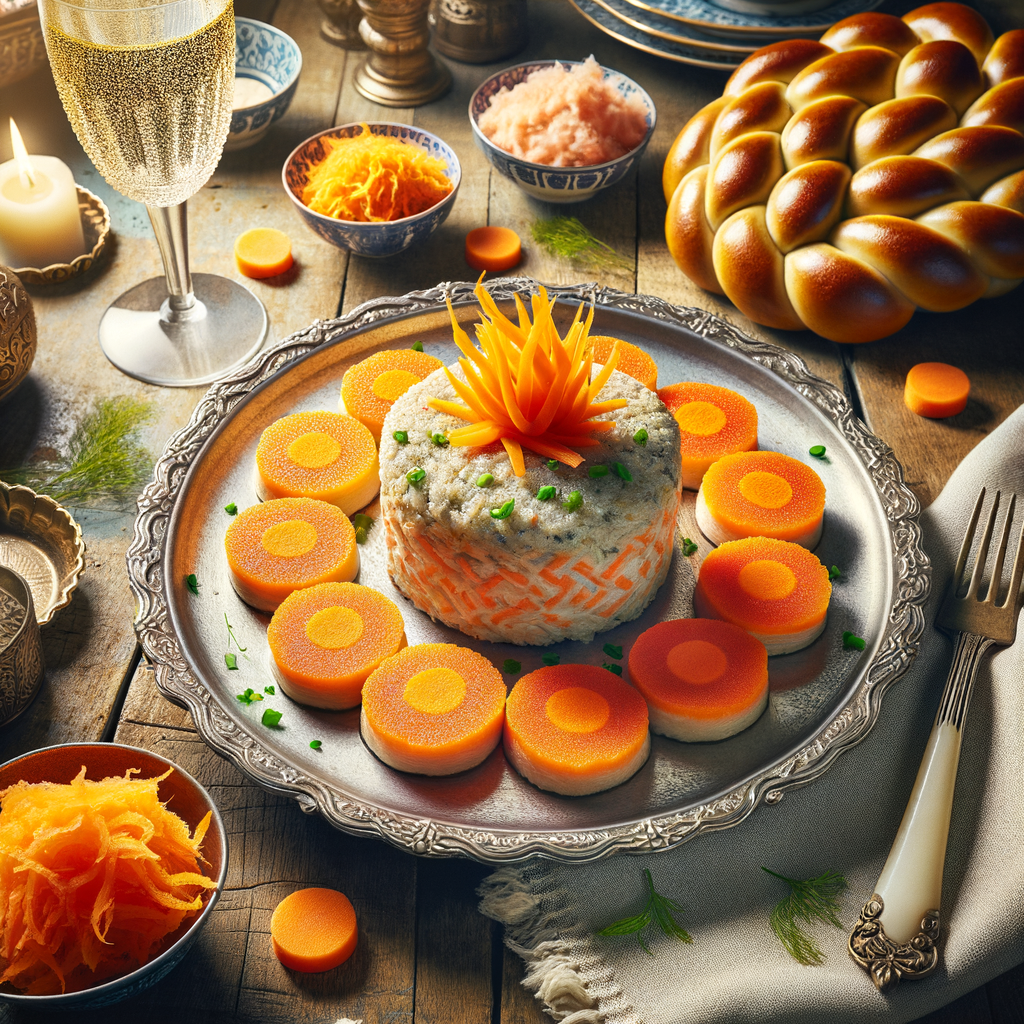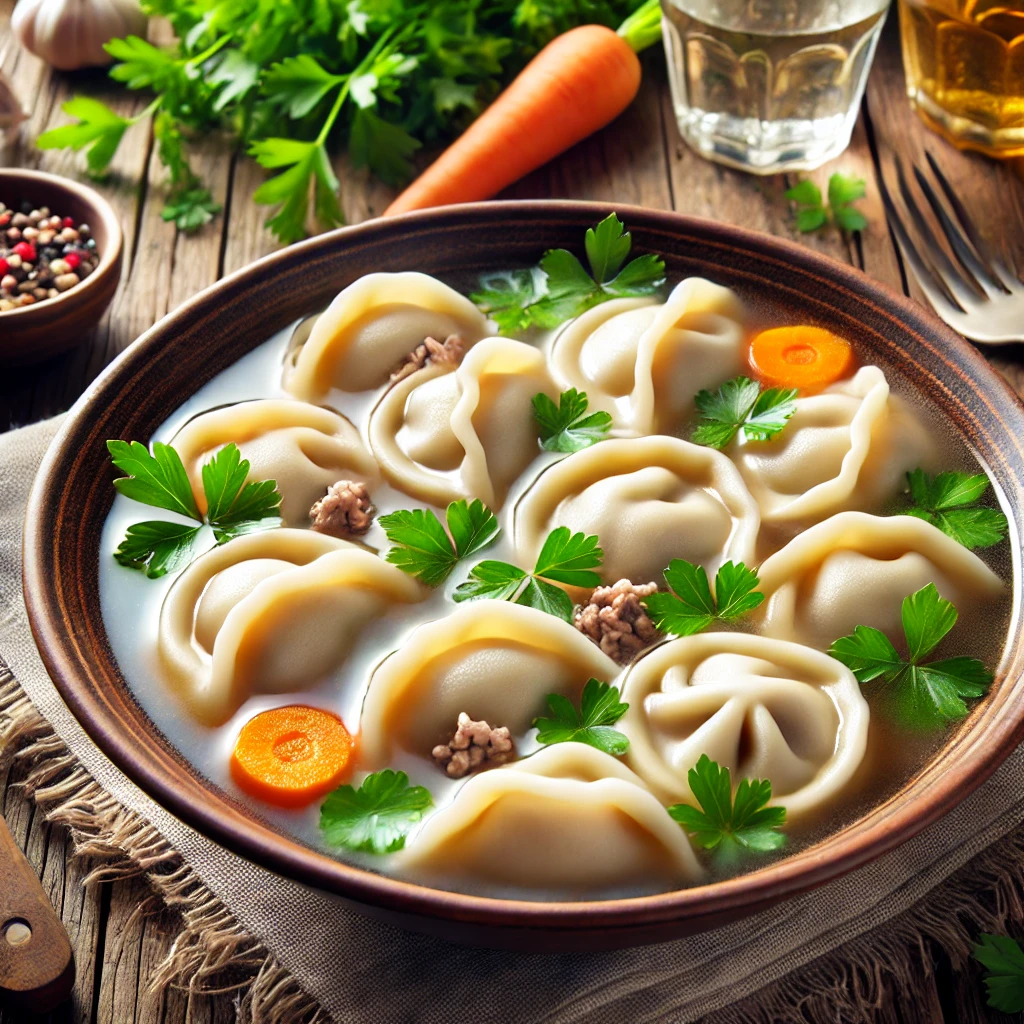
Shabbat meals are more than just nourishment; they carry deep cultural and religious significance. Traditional dishes served on this day often symbolize themes like joy, rest, and remembrance. From challah to cholent, each food has a story tied to Jewish history and tradition.
The Jewish Sabbath (Shabbat), which lasts from Friday sundown to Saturday night, is a time for family, rest, and, of course, feasting! Over centuries, Jews have a tradition of special Shabbat food —many with symbolic meanings or practical origins tied to observing the holy day.
Here are 12 traditional Shabbat foods, explaining when and why they’re eaten and what they represent.
1. Challah (Shabbat Bread) – Symbol of Blessing and Remembrance
Every Shabbat meal begins with challah, the golden, braided loaf that is blessed and shared. Two loaves are placed on the table to represent the double portion of manna that fell from heaven before the Sabbath during the Israelites’ desert wanderings
The challah is covered with a special cloth, recalling the dew that protected the manna, and it’s customary to sprinkle salt on the bread, symbolizing the ancient Temple offerings.

By breaking bread together and eating Shabbat food, families honor the divine provision and sanctity of Shabbat.
Beyond its symbolism, challah is simply delicious—its slightly sweet, egg-enriched dough makes it a centerpiece both ritually and culinarily.
Whether you’re tearing into a fluffy braid on a Friday night or enjoying leftovers as French toast the next morning, challah carries the rich “taste” of Shabbat tradition in every bite.
2. Wine (Kiddush) – Sanctification and Joy
On Friday night, before dinner, it’s traditional to bless and drink a cup of wine (or grape juice) in a ritual called Kiddush, which literally means “sanctification.”
This sweet wine signifies the joy and celebration of the Sabbath. By saying the Kiddush blessing over wine, Jews sanctify the Shabbat and mark its holiness.

Wine has deep symbolism in Judaism as a sign of happiness and divine blessing (Psalm 104 calls wine that “gladdens the heart of man”).
On Shabbat, the uplifted Kiddush cup reminds everyone that this day is special—“a taste of paradise” in Jewish thought.
3. Gefilte Fish (Fish Course) – Honoring the Sabbath with Fish
Many Ashkenazi families serve gefilte fish as a first course at Shabbat meals. This poached, seasoned fish patty (usually made of ground carp, whitefish, or pike) is often garnished with a slice of carrot and accompanied by sharp horseradish.
Eating fish on Shabbat is an old custom to honor the day; the Talmud praises enjoying fish as part of Oneg Shabbat (Sabbath delight).

Gefilte fish became the convenient way to do this because it could be prepared before Shabbat and served cold and because removing bones ahead of time avoided any prohibition of sorting on Shabbat
Beyond its practicality, gefilte fish has attained almost legendary status in Jewish culture. Love it or leave it, gefilte fish connects us to generations past who welcomed the Sabbath with this humble, hearty dish.
4. Spicy Fish (Chraime) – Sephardic Sabbath Fish Tradition
In Sephardic and Mizrahi households, Shabbat dinner might feature chraime, a spicy tomato-based fish stew. Chraime (Hebrew for “hot” or “burned”) is a North African Jewish dish of fish (often grouper or snapper) simmered in a piquant sauce of tomatoes, garlic, paprika, and cayenne.
It’s especially popular among Libyan and Moroccan Jews, often served on Friday nights and at holidays. The tradition of having fish for Shabbat spans all Jewish cultures, but Sephardic Jews definitely turn up the flavor!
Chraime is typically eaten with bread (perfect for sopping up the sauce). Its robust taste symbolizes the “spice” and pleasure of Shabbat. There’s also a spiritual symbolism in fish themselves—they were created in the water, so according to some teachings they were not affected by the Biblical flood, representing a sign of divine mercy.
5. Chicken Soup with Kneidlach (Matzo Balls) – Nurturing and Tradition
A steaming bowl of chicken soup is the heart of many Ashkenazi Shabbat dinners (and holiday meals). Often called “Jewish penicillin,” chicken soup nourishes body and soul. It’s usually served with kneidlach (matzo balls) or lokshen (egg noodles).
The tradition of starting Shabbat dinner with soup runs deep—partly for practical reasons (a warm soup on Friday night in cold Eastern Europe was much appreciated!), and partly because of the almost medicinal comfort it provides. Chicken soup on Shabbat also ties into the idea of Oneg Shabbat, taking delight in Shabbat food that can make you feel good.

Matzo balls themselves, floating like tasty dumplings, are tied to Passover but have become a year-round favorite.
Chicken soup reminds many of their grandmother’s kitchen, with the aroma of simmering broth and dill wafting through the house.
6. Cholent (Sabbath Stew) – Warmth Without Work
Cholent is the classic Shabbat stew that has enabled Jews to enjoy a hot meal on Saturday without cooking that day. By assembling it on Friday and letting it cook overnight, observant Jews adhere to the prohibition of cooking on Shabbat while still eating a hearty lunch.

Ashkenazi recipes for cholent (also called tcholent or shulent) typically contains beef, beans, and barley slow-cooked together.
Sephardic versions called hamin or adafina might include chickpeas, rice, eggs, and different spices.
The very existence of cholent is intertwined with Shabbat laws and ingenuity: “necessity was the mother…of invention, for this unctuous stew came into being as the ultimate workaround to Jewish laws prohibiting cooking on the Sabbath,” as one food historian notes.
The word “cholent” is thought to derive from French for “warm” and “slow,” reflecting its method.
On Saturday, families return from synagogue to a pot of cholent that’s been simmering on a low heat or in a slow-cooker.
7. Kugel – Comfort and Continuity
Kugel, is a staple at Shabbat and holiday meals, especially in Ashkenazi tradition.

Serving kugel on Shabbat has a practical side (it’s easy to prepare ahead and serves a crowd), but it’s also deeply traditional. In some Hasidic communities, particular kugels (like Yerushalmi kugel spiced with caramel and pepper) are almost sacred on Shabbat day.
The very word “kugel” means “sphere” or “globe” in Yiddish, harking back to when kugels were cooked in round pots or bags inside the cholent.
8. Shabbat Roast Chicken – Festive Main for Restful Days
For many Jewish families, the quintessential Shabbat dinner main course is a simple roast chicken. It might not have a specific religious symbolism, but it has become a hallmark of Ashkenazi Shabbat cooking, representing generosity and celebration.
There’s even a Yiddish song jokingly idolizing the Shabbos chicken.
Why chicken?
Historically, meat was expensive, but a chicken could be afforded or home-raised, and it was a treat reserved for Shabbat. “Even the poorest man would have a chicken for Shabbos,” it was said.
Roasting the chicken with onions, garlic, and maybe paprika or honey creates a delectable aroma that fills the home before candle-lighting. When the platter of golden roast chicken is brought out, it signals that this is no ordinary weekday meal—it’s the sacred family feast.
In some communities, people save their best poultry for Shabbat to fulfill the mitzvah (commandment) of enjoying the day. The roast chicken, often accompanied by potatoes or tzimmes (carrots), thus symbolizes the kavod (honor) given to Shabbat by eating well.
Practically speaking, roasting a chicken is easy enough to do before Shabbat and serve warm, fitting the day’s restful requirements. Juicy, tender, and comforting, Shabbat roast chicken is a tradition that carries the flavor of home and heritage.
9. Sephardic Hamin (Overnight Stew) – Sabbath Stew, Ladino-Style
Sephardic communities have their own versions of cholent known as hamin or dafina. In Morocco, for example, dafina (meaning “buried”) is a fragrant Sabbath stew featuring beef or lamb, chickpeas, spices like turmeric and cumin, and often whole eggs that slow-cook to a creamy texture.
Iraqi Jews have t’bit, a whole chicken stuffed with rice and spices simmered overnight.
No matter the name, these dishes serve the same purpose as cholent: a hot meal ready on Shabbat day. But they also carry unique meanings. Take the hard-boiled eggs in hamin, called huevos haminados—they come out brown and are often symbolic of life and renewal.

The practice of slow-cooking for Shabbat likely dates to Talmudic times, and Sephardic Jews, spread from Spain to the Middle East, each added local ingredients. What unites all hamins is the idea of communal dining and patience.
On Shabbat morning in Sephardic neighborhoods, families would send a child to fetch the pot from the baker’s oven or coals, the aroma mingling with the sounds of Ladino or Arabic hymns.
Hamin is more than sustenance; it’s a cultural touchstone. Tasting it, you get layers of flavor—warming spices, savory meats, soft legumes—that reflect the tapestry of Sephardic Jewish life and the dedication to keeping Shabbat traditions, wherever Jews wandered.
10. Yemenite Jachnun – A Special Shabbat Morning Treat
In Yemenite Jewish tradition, Shabbat morning is often greeted with jachnun, a unique slow-baked bread. Jachnun are rolls of dough enriched with clarified butter or shortening, rolled up tight and baked at a low temperature all night.
They emerge caramel-colored, flaky, and slightly sweet. Eaten on Shabbat day with a fresh grated tomato sauce, hard-boiled eggs, and spicy schug (Yemenite hot sauce), jachnun is a beloved treat that Yemenite Jews brought with them to Israel.
Why jachnun?
In Yemen, Jews could not bake bread on Shabbat, so they devised this ingenious pastry that could bake slowly from before sundown until the next morning. It exemplifies the creativity of Jewish cooks in observing Shabbat rules.
The process of making it is labor-intensive (today many buy it frozen or from bakeries), which itself is an act of love and devotion. When you bite into jachnun’s soft, laminated layers and taste that buttery, slightly malty flavor, you experience a direct link to the Jewish community of Yemen and their way of sanctifying Shabbat morning with something delicious and unique.
11. Shabbat Dessert (Babka or Kugelhopf) – Sweet Endings for a Sweet Day
While Shabbat doesn’t have one exclusive dessert, it’s customary to end the Friday night meal with a sweet treat—symbolically hoping for a sweet week to come.
Different communities have different favorites:
Eastern European Jews might serve babka (a yeasted cake-bread swirled with chocolate or cinnamon) or sponge cake, while Sephardic Jews might enjoy tishpishti (a syrup-soaked semolina cake) or fruits and nuts.

In North America, a simple bundt cake or cookies with tea often does the job. What’s important is the sweetness. There’s a beautiful saying that Shabbat is a taste of the world to come, so naturally, it should end on a sweet note.
Whether it’s a slice of chocolate rugelach or a piece of moist apple strudel, the dessert signals the close of the Shabbat meal.
12. Kreplach – Savory Dumplings of Comfort
Kreplach are dumplings filled with seasoned meat, often served in the warm embrace of chicken soup during Shabbat dinner. Commonly filled with ground beef or chicken, they are sometimes flavored with onions and spices, adding depth to each bite.

The origins of kreplach date back centuries and can be found in various Jewish communities, from Ashkenazi to Sephardic traditions.
As kreplach simmer gently in the soup, they absorb the rich flavors, transforming them into a delectable treat that reinforces the importance of sharing wholesome Shabbat food with loved ones.
Conclusion
Together, these Shabbat foods create a tapestry of meaning and memory. Some (like challah and wine) are explicitly ritual, while others (like roast chicken or salads) have become traditional through cultural practice.
By enjoying Shabbat Food in a restful, appreciative state of mind, families everywhere continue to “make Shabbat” as much with their dining room tables as with their prayer books – fulfilling the biblical injunction to “call the Sabbath a delight.”


